Catholic Customs
 |
 |
 |
 |
 |
 |
 |
Christmas Greenery: Hope for Everlasting Life
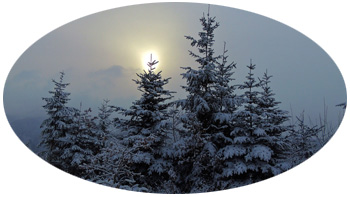
Evergreens bring hope amidst a cold, lifeless winter
What color better expresses new life and the coming of the Redeemer than green? Is not the sight of a green bud or an evergreen bough a source of hope to peoples in cold winter climates living through the gray, dark month of December? A hope that, like the evergreen that never loses its luster, so also man will have eternal life.
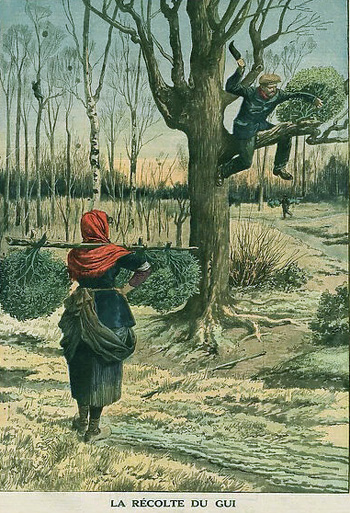
Gathering the mistletoe & greens in France
Christ was born at the time of the Winter Solstice to show His glory, as St. Gregory of Nyssa so strikingly says: "On this day which the Lord hath made, darkness decreases, light increases, and night is driven back again. No, brethren, it is not by chance, nor by any created will, that this natural change begins on the day when He shows Himself in the brightness of His coming, which is the spiritual Life of the world." (1)
The victory of the sun with its lengthening days occurs in December, because December 25 was the day ordained before the beginning of time for the true Sun to look upon this earth from the arms of His Virgin Mother.
Adorning the Christmas Hall
In Northern and Central Europe and the British Isles, medieval Catholics began to adorn their homes and palaces with evergreens and other greenery at Christmas to honor Our Savior who came to give eternal life. On the Continent, fir, spruce, holly and yew were the choice greenery, while on the British Isles, holly, laurel, mistletoe and rosemary were used. (2)
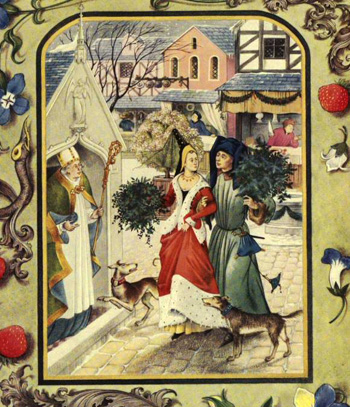
A medieval couple bringing home
their Christmas greenery
On Christmas Eve, a great spirit of expectation filled every palace, village and farm. Men, women, and children ventured into the woods and fields to collect greenery and flowers to fittingly decorate their homes for the grandest of feasts.
The great medieval halls required a multitude of greens, so young men and women often began collecting the greenery a week before Christmas. However, following an ancient custom that was strictly adhered to, none of the decor was brought inside until Christmas Eve (3)
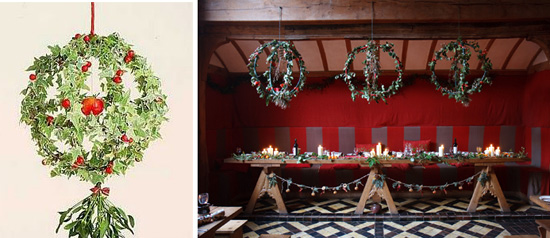
A hall decorated with Christmas balls of greenery
Hidden symbolism of the greenery
The evergreen was a symbol of eternal life, but many of the species had their own unique meanings. One such evergreen still popular in the British Isles is the Holly, whose prickly leaves are symbolic of Our Lord’s crown of thorns and red berries, the Precious Blood that Christ shed. The Holly was also symbolic of the burning bush that Moses beheld and of Our Lady’s burning love that consumed but did not scorch her Immaculate Heart. (5) Such was the reverence for the holly that in Ireland people said that an Angel stood on every spike of a holly leaf. (6)
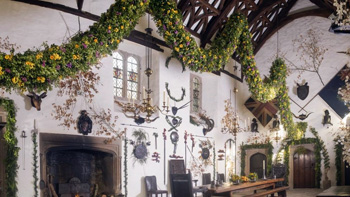
Greenery of every type adorns a medieval hall
So sacred was its presence that enemies that happened to meet under its leaves made a truce for the day and greeted each other warmly. This led to a later customs of suspending mistletoe in a room as a token of peace and good will to all.
There is much evidence showing that mistletoe was used to adorn churches along with other evergreens since early times in the British Isles. (7) A large bundle of mistletoe was solemnly placed on the altar of the Cathedral of York every year at Christmas to symbolize Our Lord, who is the Divine Healer of nations, the true “healall.”
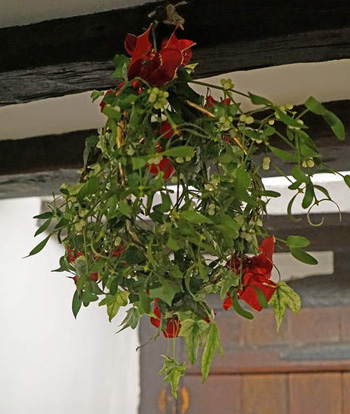
From afar we come, and our staves
Are adorned with laurel;
To seek Jesus, the King, the Savior great,
And to bring Him laurel. (8)
One traditional medieval decoration was the Christmas bush that consisted of evergreen boughs arranged on a circular or square wooden frame adorned with apples, oranges, nuts and paper or cloth ornaments. (9)
The French preserve this custom in homes that remain faithful to old traditions. The wreath is called the arbre de Nau, and is adorned with nuts, apples and colorful eggs and prominently hung in the kitchen or sitting room. (10)
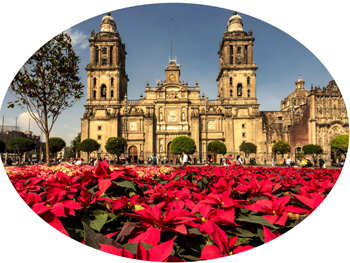
Masses of poinsettias in front of Jalisco's Cathedral in Mexico
In Mexico and the United States, the poinsettia – whose bright red center resembles the star of Bethlehem – has become a beloved traditional decor. Native to Mexico, there it is called Flor de la Noche Buena (Flower of the Holy Night). According to legend, it sprung up at the feet of a poor girl Pepita who longed to bring a worthy gift to the church for the Christ Child. (11)
Thus, were the homes of Christendom transformed into Gardens of Paradise on the Eve of the birth of the King of Kings, the Lord of Heaven and Earth.
Continued
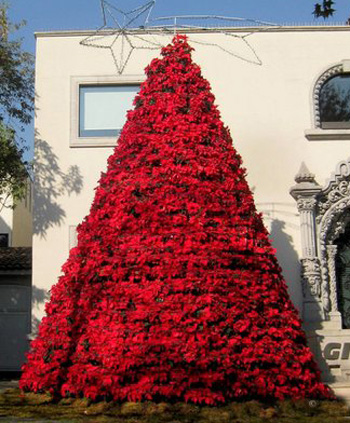
Poinsettia trees are popular in Latin America
- James L. Monks, Great Catholic Festivals (London: Abelard-Schuman Ltd., 1958), p. 6.
- Francis X. Weiser, The Christmas Book (New York: Harcourt, Brace and Company, 1952), p. 124.
- Mary P. Pringle and Clara A. Urann, Yule-tide in Many Lands (Boston: Lothrop Lee and Shepard Co., 1916), p. 37.
- Madeleine Pelner Cosman, Medieval Holidays and Festivals: A Calendar of Celebrations (New York: Charles Scribner’s Sons, 1981), p. 91.
- Weiser, The Christmas Book
- Steve Roud, The English Year (Penguin Books: 2006), p. 382.
- Weiser, The Christmas Book, p. 125-130.
- Madeleine Pelner Cosman, Medieval Holidays and Festivals: A Calendar of Celebrations (New York: Charles Scribner’s Sons, 1981), p. 92.
- Mary P. Pringle and Clara A. Urann, Yule-tide in Many Lands (Boston: Lothrop Lee and Shepard Co., 1916), p. 122.
- Weiser, The Christmas Book, p. 133; See also The Famerer’s Almanac, https://www.almanac.com/poinsettia-christmas-story

Posted December 4, 2023
______________________
______________________
 |
 |
 |
 |
 |
 |


